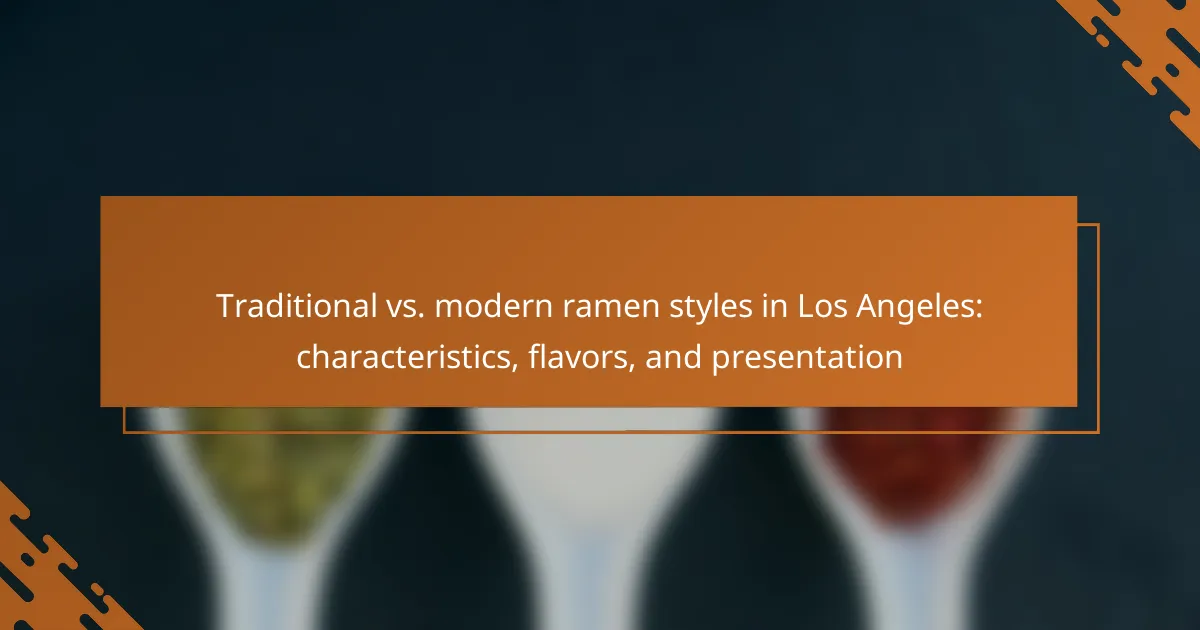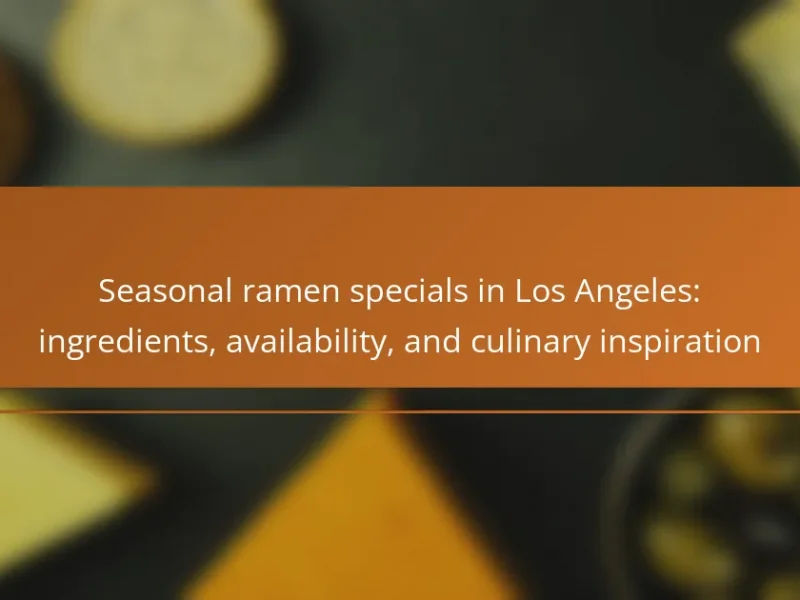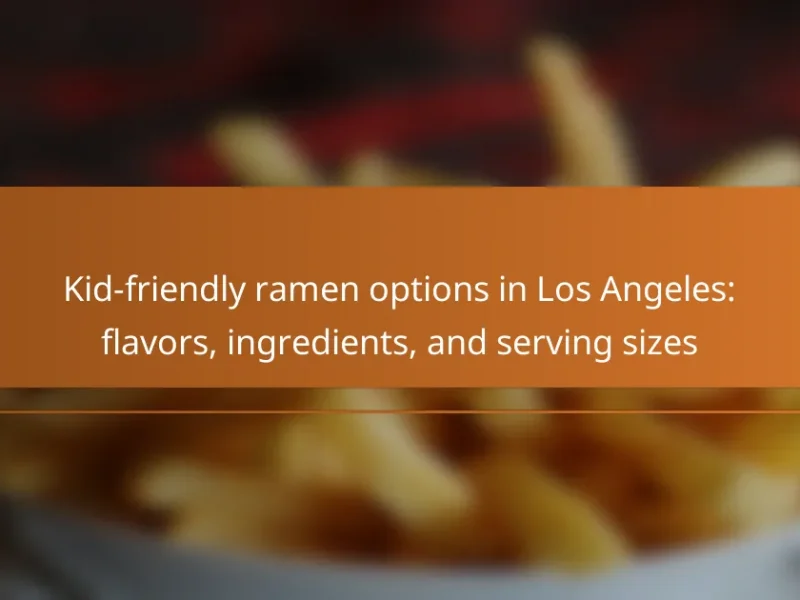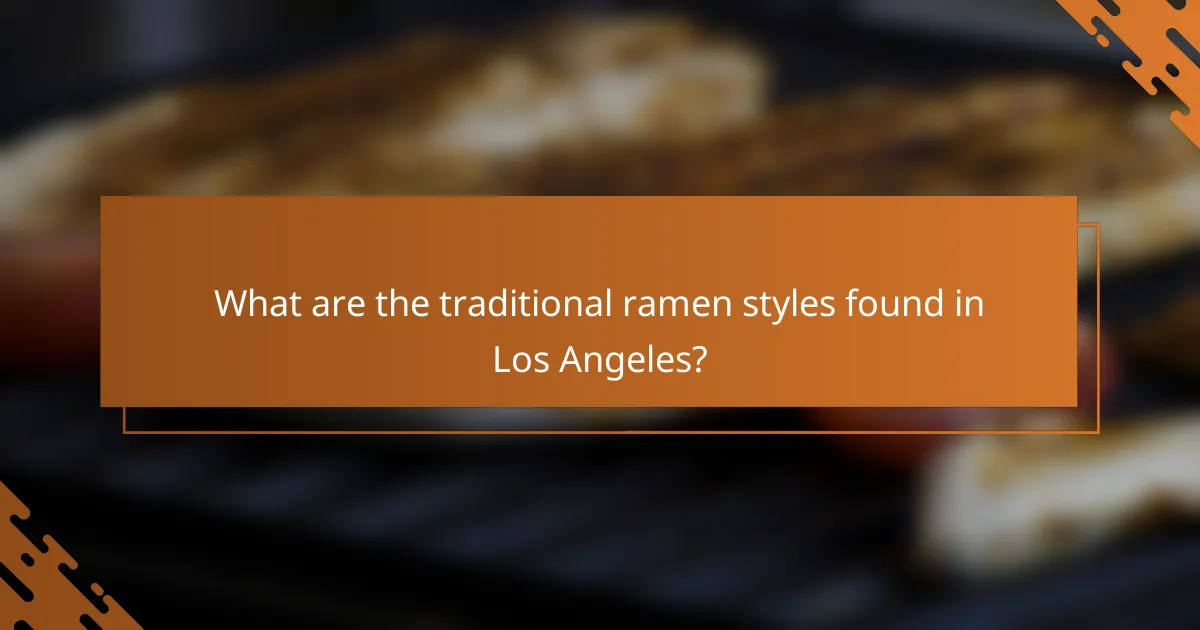
What are the traditional ramen styles found in Los Angeles?
The traditional ramen styles found in Los Angeles include Shoyu, Miso, Tonkotsu, and Shio. Shoyu ramen features a soy sauce-based broth, providing a savory flavor. Miso ramen incorporates fermented soybean paste, adding richness and depth. Tonkotsu ramen is known for its creamy pork bone broth, resulting in a hearty taste. Shio ramen uses a salt-based broth, offering a lighter flavor profile. These styles reflect the diverse culinary influences in Los Angeles. The popularity of these traditional styles can be seen in numerous ramen shops across the city.
How do traditional ramen styles differ from modern interpretations?
Traditional ramen styles focus on authentic regional recipes and ingredients. They often emphasize a rich, deep broth made from pork bones or chicken. Traditional toppings include chashu, menma, and green onions. The noodles are typically handmade and have a chewy texture.
Modern interpretations often experiment with flavors and ingredients. They may include fusion elements, like spicy miso or vegan options. Modern ramen shops often prioritize presentation, using artistic plating techniques. They may also offer unique toppings such as avocado or fried chicken.
In Los Angeles, the ramen scene showcases both styles, highlighting the contrast between tradition and innovation.
What are the key characteristics of traditional ramen?
Traditional ramen is characterized by its rich broth, distinct noodles, and specific toppings. The broth is often made from pork bones, chicken, or seafood, simmered for hours to develop deep flavors. Noodles are typically wheat-based, with a chewy texture that complements the broth. Common toppings include sliced pork (chashu), green onions, bamboo shoots, and a soft-boiled egg. Traditional ramen is usually served in a bowl with a balanced combination of flavors and textures. The dish emphasizes umami, achieved through ingredients like soy sauce or miso. Each region in Japan has its own variation, reflecting local ingredients and culinary traditions.
Which ingredients define traditional ramen styles?
Traditional ramen styles are defined by specific ingredients. Key components include wheat noodles, which provide the base. Broth is essential, often made from pork, chicken, or seafood. Tare, a seasoning sauce, enhances flavor, typically featuring soy sauce or miso. Toppings commonly include sliced chashu (braised pork), menma (bamboo shoots), and green onions. Nori (seaweed) is also a standard garnish. Each ingredient contributes to the distinct taste and texture of traditional ramen. The combination of these elements creates a rich culinary experience unique to ramen.
What flavors are commonly associated with traditional ramen?
Traditional ramen commonly features flavors such as soy sauce, miso, and salt. These flavors are often derived from the broth, which is a fundamental element of ramen. Soy sauce ramen, known as shoyu, offers a savory and slightly sweet taste. Miso ramen provides a rich and hearty flavor profile, while shio ramen, or salt ramen, is lighter and more delicate. Additionally, the use of toppings like green onions, nori, and pork enhances the overall flavor experience. The balance of these flavors is crucial in achieving the authentic taste of traditional ramen.
How do broth types influence the flavor profile of traditional ramen?
Broth types significantly influence the flavor profile of traditional ramen. Different broth bases create unique taste experiences. Shoyu broth offers a savory, umami-rich flavor due to soy sauce. Miso broth adds a rich, slightly sweet taste from fermented soybean paste. Tonkotsu broth provides a creamy, hearty flavor derived from pork bones. Each broth type affects the overall balance of flavors in the dish. For instance, a lighter broth may enhance the freshness of toppings. Conversely, a richer broth can create a more filling meal. The choice of broth is essential to defining the ramen’s character. Traditional ramen styles often emphasize these distinct broth flavors, showcasing regional variations.
What role do toppings play in enhancing traditional ramen flavors?
Toppings play a crucial role in enhancing traditional ramen flavors. They add texture, depth, and complexity to the dish. Common toppings include chashu (braised pork), which contributes rich umami. Menma (bamboo shoots) adds a crunchy contrast. Soft-boiled eggs provide creaminess and additional protein. Green onions offer freshness and a mild onion flavor. Nori (seaweed) introduces a subtle brininess. Each topping complements the broth and noodles, creating a balanced flavor profile. According to ramen experts, the careful selection of toppings can elevate the overall dining experience, making each bowl unique and flavorful.
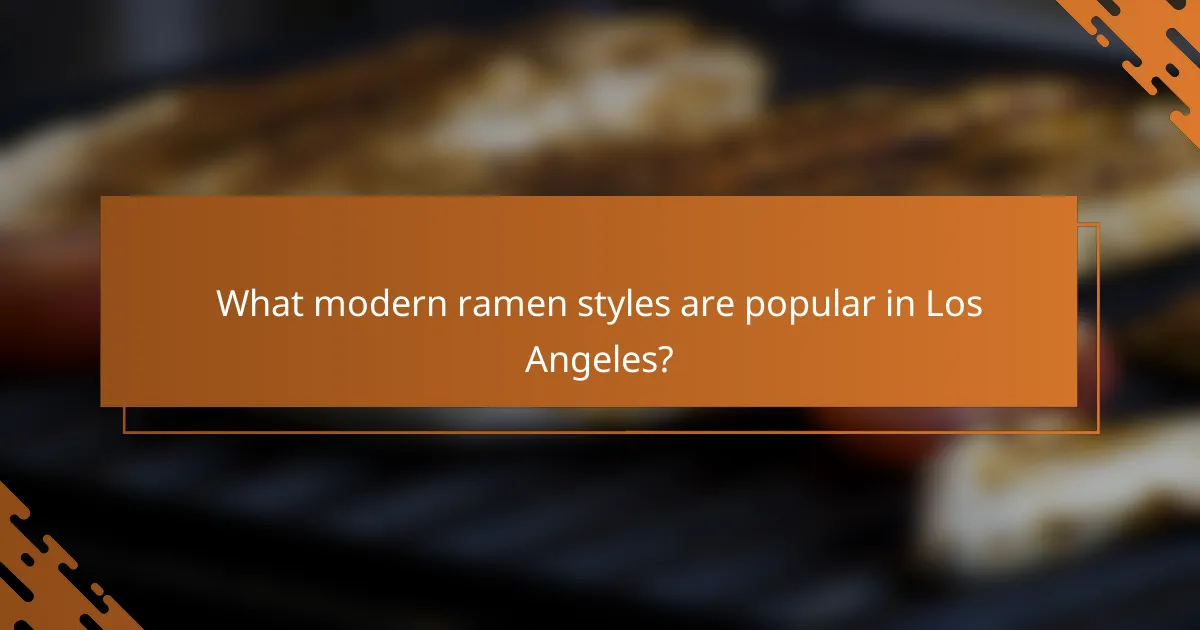
What modern ramen styles are popular in Los Angeles?
Modern ramen styles popular in Los Angeles include Tonkotsu, Shoyu, and Spicy Miso. Tonkotsu ramen features a rich pork bone broth, known for its creamy texture. This style has gained significant popularity due to its depth of flavor and satisfying mouthfeel. Shoyu ramen is characterized by its soy sauce-based broth, offering a lighter yet savory profile. Many ramen shops in Los Angeles highlight this style for its balance of flavors. Spicy Miso ramen combines traditional miso with chili paste, creating a bold and spicy experience. This fusion appeals to those seeking a kick in their ramen. Each of these styles reflects the diverse culinary landscape of Los Angeles, attracting ramen enthusiasts from various backgrounds.
How have modern ramen styles evolved from traditional ones?
Modern ramen styles have evolved significantly from traditional ones by incorporating diverse ingredients and techniques. Traditional ramen typically features a simple broth, wheat noodles, and basic toppings. In contrast, modern ramen often includes innovative broths like tonkotsu, miso, or even vegan options.
Additionally, modern ramen shops frequently experiment with fusion flavors, blending international cuisines. For instance, some establishments offer spicy kimchi ramen or truffle oil-infused bowls. The presentation has also changed; modern ramen is often served in artistic, Instagram-friendly styles.
Moreover, the rise of gourmet ramen has led to the use of high-quality, artisanal ingredients. This evolution reflects a broader trend of culinary creativity and consumer demand for unique dining experiences. Overall, modern ramen represents a fusion of tradition and innovation, adapting to contemporary tastes while honoring its roots.
What unique ingredients are often used in modern ramen?
Modern ramen often features unique ingredients such as truffle oil, miso paste, and smoked meats. These ingredients enhance the flavor profile and elevate the dish beyond traditional recipes. Truffle oil adds an earthy aroma and richness. Miso paste introduces a savory umami depth. Smoked meats provide a distinct taste and texture contrast. Other unique ingredients include corn, chili oil, and seasonal vegetables. Corn adds sweetness, while chili oil introduces heat. Seasonal vegetables contribute freshness and color. These ingredients reflect the innovative approaches of contemporary ramen chefs in Los Angeles.
How do presentation styles differ in modern ramen?
Modern ramen presentation styles differ significantly from traditional ones. Traditional ramen typically emphasizes a simple, rustic presentation. It often features a single bowl with noodles and broth, garnished with basic toppings. Modern ramen, however, showcases artistic and elaborate presentations. Chefs often layer ingredients creatively, using vibrant colors and textures.
Modern styles may include unique garnishes like edible flowers or gourmet toppings. Presentation can also involve the use of varied bowl shapes and sizes. Additionally, some modern ramen shops incorporate thematic designs that reflect cultural influences. This evolution in presentation enhances the dining experience and attracts a diverse clientele.
What flavors characterize modern ramen styles?
Modern ramen styles are characterized by diverse flavors that go beyond traditional profiles. Common flavors include rich tonkotsu, made from pork bones, and shoyu, which is soy sauce-based. Additionally, miso ramen offers a savory, fermented taste. Some modern variations incorporate unique ingredients like truffle oil, spicy miso, and seafood-based broths. These flavors reflect a fusion of culinary influences. The use of fresh, local ingredients also enhances flavor complexity. Many ramen shops in Los Angeles experiment with toppings such as corn, butter, and even cheese. This exploration of flavors showcases the evolving nature of ramen in contemporary cuisine.
How do innovative techniques impact the flavor of modern ramen?
Innovative techniques significantly enhance the flavor of modern ramen. Techniques such as sous-vide cooking allow for precise temperature control. This results in tender meats infused with rich flavors. Additionally, the use of fermentation introduces complex umami profiles. For example, miso or tare made through fermentation adds depth to the broth. Techniques like smoking or char-grilling ingredients create unique flavor layers. Furthermore, modern ramen chefs experiment with unconventional ingredients, such as truffles or unique spices. This experimentation broadens the flavor spectrum beyond traditional boundaries. Overall, innovative techniques contribute to a more diverse and flavorful ramen experience.
What are some popular toppings in modern ramen dishes?
Popular toppings in modern ramen dishes include chashu, soft-boiled eggs, and nori. Chashu is braised pork belly, known for its tenderness and rich flavor. Soft-boiled eggs are typically marinated, adding a creamy texture. Nori provides a savory umami taste and a crunchy texture. Other common toppings are menma, which are fermented bamboo shoots, and green onions for freshness. Corn and butter are also popular, especially in Hokkaido-style ramen. These toppings enhance the overall flavor profile and presentation of modern ramen dishes.
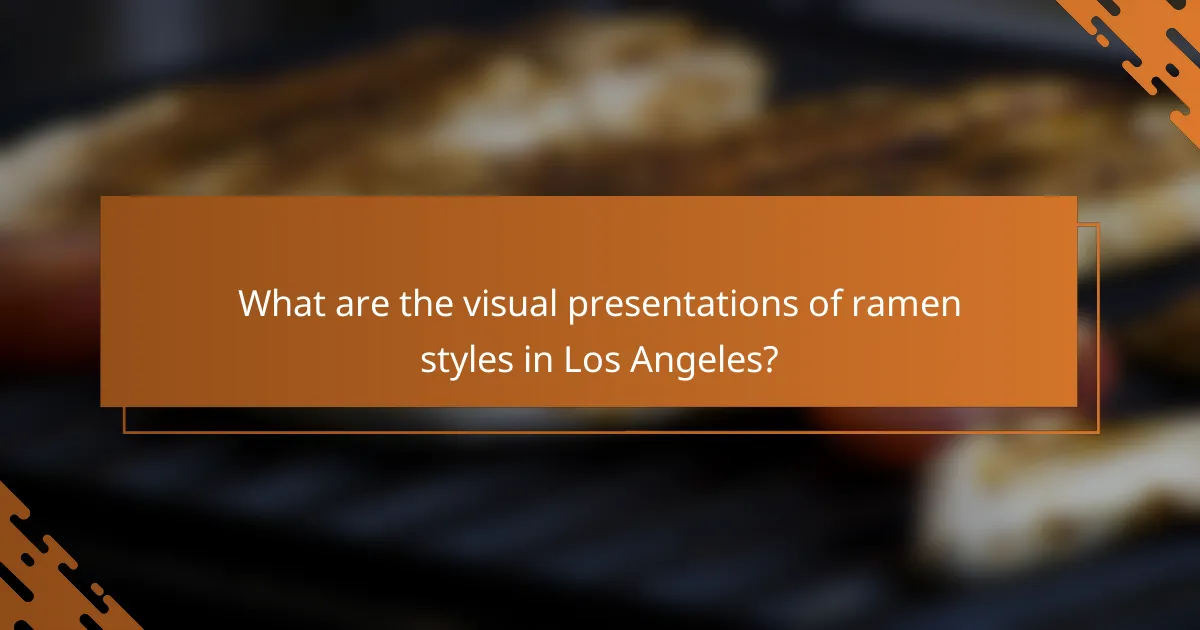
What are the visual presentations of ramen styles in Los Angeles?
Ramen styles in Los Angeles exhibit diverse visual presentations. Traditional ramen often features a rich, golden broth with toppings arranged artfully. Common toppings include chashu (braised pork), narutomaki (fish cake), and green onions. Modern ramen may present a more eclectic aesthetic. This style often incorporates vibrant ingredients like black garlic oil and spicy miso. The noodles are typically handmade, showcasing a chewy texture. Bowls may also include unique garnishes, such as soft-boiled eggs or pickled vegetables. Many restaurants emphasize plating, using colorful bowls to enhance visual appeal. Overall, the visual presentation of ramen reflects both cultural heritage and contemporary culinary trends.
How does the presentation of traditional ramen differ from modern ramen?
Traditional ramen is typically presented in a more minimalist and rustic style. It often features a simple bowl with a clear broth and basic toppings. Common toppings include sliced pork, green onions, and a soft-boiled egg. The emphasis is on showcasing the broth’s clarity and flavor.
In contrast, modern ramen often embraces a more elaborate presentation. It may include a wider variety of toppings, such as corn, cheese, or even truffle oil. The bowls are often more colorful and visually appealing. Some modern interpretations also incorporate artistic plating techniques.
The differences reflect a shift in culinary trends, where modern ramen aims to create an Instagram-worthy experience. This evolution in presentation mirrors the growing fusion of traditional and contemporary culinary practices.
What visual elements are emphasized in traditional ramen presentation?
Traditional ramen presentation emphasizes vibrant colors, contrasting textures, and carefully arranged ingredients. The broth is often clear and rich in color, showcasing its depth. Noodles are typically placed in a neat mound, highlighting their texture. Toppings, such as sliced chashu, green onions, and nori, are artfully arranged to create visual appeal. The use of garnishes like sesame seeds adds an extra layer of texture and color. Bowls are often chosen for their aesthetic qualities, enhancing the overall presentation. The combination of these elements creates a visually striking dish that reflects the care and craftsmanship involved in traditional ramen preparation.
What are the trends in modern ramen presentation styles?
Modern ramen presentation styles emphasize visual appeal and creativity. Chefs often use vibrant colors and artistic plating techniques. Ingredients are arranged thoughtfully to enhance aesthetics. Unique bowls and dishware are also popular for serving. Toppings like edible flowers or microgreens add freshness and color. Layering ingredients creates depth and interest. Some restaurants incorporate themed presentations for special occasions. Overall, modern ramen focuses on both taste and visual artistry.
Why is presentation important in ramen dining experiences?
Presentation is important in ramen dining experiences because it enhances the overall sensory appeal. A visually appealing bowl of ramen can stimulate appetite and create anticipation. Ingredients are arranged thoughtfully, showcasing colors and textures. This artistic presentation aligns with Japanese culinary traditions that value aesthetics. Studies show that food presentation influences perception of taste. For example, a well-presented dish can enhance flavor perception by up to 20%. In Los Angeles, both traditional and modern ramen styles emphasize this aspect to attract diners. Ultimately, presentation plays a crucial role in elevating the dining experience.
How does presentation affect customer perception of ramen quality?
Presentation significantly influences customer perception of ramen quality. A visually appealing dish enhances the expectation of taste and freshness. Bright colors, careful arrangement, and garnishes create an impression of culinary artistry. Studies show that attractive food presentation can increase perceived value by up to 30%. Additionally, customers often associate well-presented meals with higher quality ingredients. In the competitive ramen market of Los Angeles, effective presentation can differentiate a restaurant from its competitors. Therefore, the way ramen is presented directly impacts customer satisfaction and repeat business.
What tips can enhance your ramen experience in Los Angeles?
To enhance your ramen experience in Los Angeles, explore different styles offered by various restaurants. Traditional ramen often features rich, slow-cooked broths. Modern interpretations may include unique ingredients and fusion flavors. Visit ramen spots during off-peak hours for a relaxed dining experience. Pair your ramen with traditional sides like gyoza or edamame for added flavor. Pay attention to the type of noodles used; they can vary significantly in texture and taste. Consider trying a variety of toppings to customize your bowl. Research local reviews to find highly-rated establishments known for their ramen. Engaging with the ramen community can provide insights into hidden gems and seasonal offerings.
The main entity of this article is ramen, specifically focusing on traditional and modern styles found in Los Angeles. The article outlines the characteristics, flavors, and presentation differences between traditional ramen styles such as Shoyu, Miso, Tonkotsu, and Shio, and their modern interpretations that incorporate innovative ingredients and presentation techniques. Key aspects include the influence of broth types on flavor profiles, the role of toppings in enhancing taste, and the evolution of ramen presentation from rustic to artistic. Additionally, it provides tips for enhancing the ramen dining experience in Los Angeles, emphasizing the importance of exploring various styles and local establishments.
